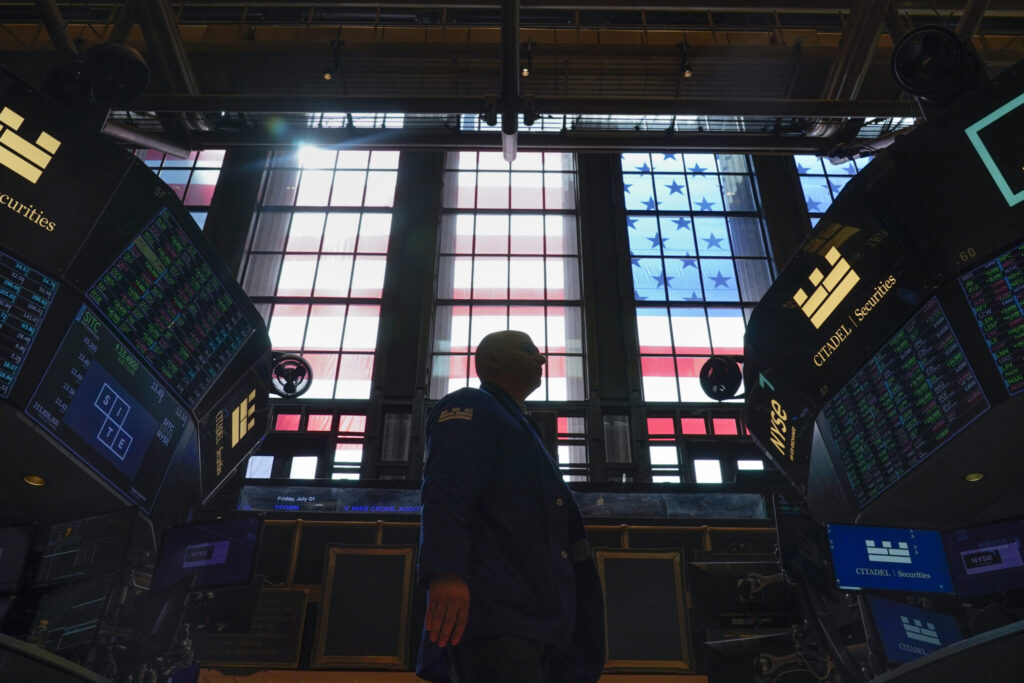The stock market is still absorbing the Federal Reserve’s warning from a day earlier that it could raise interest rates two more times this year in its battle against inflation. It’s already hiked its benchmark overnight rate to the highest level since 2007, which has helped slow inflation somewhat but has also caused sharp pain in several areas of the economy, as reported by the Associated Press:
Wall Street drifts near highest level since 2022
Newslooks- NEW YORK (AP)
Wall Street is drifting Thursday following a messy mix of economic reports that yielded no clear sign about where the economy and inflation are heading.
The S&P 500 was 0.2% higher in early trading, coming off its highest level since April 2022. The Dow Jones Industrial Average was up 122 points, or 0.4%, at 34,096, as of 9:50 a.m. Eastern time, while the Nasdaq composite was virtually unchanged.
Kroger sank to one of the market’s sharper losses after reporting slightly weaker revenue for the latest quarter than expected. It fell 2.6% despite also reporting stronger profit than expected and reaffirming many of its financial forecasts for the year. Homebuilder Lennar rose 3.8% to help lead the S&P 500 after reporting stronger profit and revenue than expected.
The stock market is still absorbing the Federal Reserve’s warning from a day earlier that it could raise interest rates two more times this year in its battle against inflation. It’s already hiked its benchmark overnight rate to the highest level since 2007, which has helped slow inflation somewhat but has also caused sharp pain in several areas of the economy.
The Fed is trying to find the right level for rates where it can slow spending by Americans enough to get inflation under control but not so much that it causes a deep recession. Reports on Thursday offered a mixed picture of how it’s going. Uncertainty is high after the Fed’s warning from Wednesday shook investors who had been expecting just one more increase to rates this year.
Sales at U.S. retailers unexpectedly strengthened last month, when economists were forecasting a drop. That could be a sign that spending by consumers overall is holding up despite more expensive rates on credit cards and other loans.
But underneath the surface, the numbers were a touch weaker than expected after ignoring sales of autos, fuel and some other areas. Those numbers feed into the U.S. government’s estimates for the overall economy’s growth.
A separate report said slightly more workers applied for unemployment benefits last week than expected. Though the number is still low compared with history, a tick higher could be a sign that a remarkably resilient job market is finally starting to loosen following the Fed’s barrage of rate hikes since early last year.
In manufacturing, meanwhile, the impact of higher rates has been more clear. The industry has been contracting for months, though it accounts for only a relatively small part of the economy.
One report Thursday said manufacturing activity in the mid-Atlantic region suffered its 10th straight month of contraction. Another, though, said sentiment among manufacturers in New York state unexpectedly improved this month.
Treasury yields slumped after the reports. The yield on the 10-year Treasury fell to 3.72% from more than 3.80% before the reports’ release and from 3.79% late Wednesday. It helps set rates for mortgages and other important loans.
The two-year yield, which moves more on expectations for the Fed, fell to 4.65% from 4.69% late Wednesday.
The Fed isn’t alone in keeping the pressure up on interest rates in order to battle inflation. The European Central Bank raised rates on Thursday and pledged more are on the way, including at its next meeting in July.
Stocks were down in Europe, with France’s index 0.9% lower and Germany’s 0.6%.
Asian stocks were mixed. Chinese indexes rose amid hopes for more stimulus from its central bank as the recovery for the world’s second-largest economy from anti-COVID restrictions stumbles.
Stock indexes roses 2.2% in Hong Kong and 0.7% in Shanghai.
In Japan, machinery orders for April showed the first growth in three months. Trade figures for May showed a deficit for 22 months in a row, as import costs rose with the rising energy and other prices.
Japan’s benchmark Nikkei 225 erased morning gains to finish down 0.1%.







